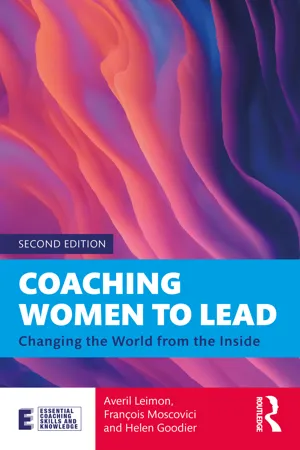
Coaching Women to Lead
Changing the World from the Inside
Averil Leimon, François Moscovici, Helen Goodier
- 262 pages
- English
- ePUB (adapté aux mobiles)
- Disponible sur iOS et Android
Coaching Women to Lead
Changing the World from the Inside
Averil Leimon, François Moscovici, Helen Goodier
À propos de ce livre
Ten years ago, the first edition of this book asked why there was such a low number of women filling leadership roles and outlined what it took for women to succeed in their careers. Since then, headline numbers have gone up but has there been real change? This new edition continues a deep investigation into underlying issues and coaching responses. Building on the first edition's original research with the London School of Economics, the authors revisit all assumptions, adding millennials and beyond, as well as a broader selection of industry sectors. In this book, you will find:
- How to build a business case for coaching women specific to your organisation.
- Which areas of coaching are the most useful at which stage of long careers – not just age.
- Refreshed interviews with past and new women leaders.
- Specific tools and techniques to develop women leaders and build more women-friendly organisations.
-
The original research clearly stands, so do the core elements of coaching that lead to success. This book will be of great interest to coaches, women leaders, professional managers and academics.
Foire aux questions
Informations
1Why women? – The need to differentiate in coaching
- The American approach was to ignore that people had a gender, treat everybody equally and fairly, by the same rules – i.e., those put in place by men over the past 100 years of corporate life; and
- The European one which taught women to recognise and build on their differences, sometimes using unique skills, sometimes exploiting men's stereotypes of working women.
- Are there objective reasons to treat women differently in coaching?
- What should women be coached about and at what stage of their career?
- Are there any techniques and approaches that work particularly well when coaching women?
- We built a robust business case to demonstrate that coaching women to lead is clearly worth the effort;
- We did the obvious to find out about needs: we asked women! and
- We also trawled the world for examples of gender-specific coaching, looked at our own practice and asked coached women what had been the most useful in their own coaching.
Chapter 2: Why bother with women leaders? – The business case for coaching
- Why most economies – East and West – face a ‘leadership cliff’ and how women could help make up this leadership deficit;
- The cash benefits of gender diversity; and
- How to calculate the value of actively managing the pipeline of women leaders in order to increase talent retention and save recruitment and associated costs.
Chapter 3: What are the critical stages of a woman's career and their coaching requirements?
Chapter 4: What do women want? – Reporting the results of our research
- the perceived key drivers of success for women in a corporate environment;
- the biggest challenges at all levels;
- advice given to other women in a corporate context in all areas including confidence, gender behaviour, career strategies, emotional advice, etc.; and
- coaching implications.
Chapter 5: In search of role models – Conversations with exemplary women
Chapter 6: 10 years on – What our role models report
Chapter 7: Coaching women to lead – A systematic approach to coaching women for success
- Confidence
- Networking
- Role models
- Balancing career and family
- Resilience
- Navigating the labyrinth
- Playing the game
- Developing presence
- Developing into a leader
- Negotiating life
Chapter 8: What makes a strong leader? – A model for women's leadership development
- Visible
- Resilient
- Strategic
- Emotional
- Decisive
- Intellectual
- Behavioural
- Meaningful
Chapter 9: How to develop a woman-friendly organisation
Table des matières
- Cover Page
- Endorsements Page
- Half-Title Page
- Series Page
- Title Page
- Copyright Page
- Dedication Page
- Contents
- List of figures and tables
- Preface
- 1 Why women? – The need to differentiate in coaching
- 2 Why bother with women leaders? – The business case for coaching
- 3 What are the critical stages of a woman's career and their coaching requirements?
- 4 What do women want? – Reporting the results of our research
- 5 In search of role models – Conversations with exemplary women
- 6 10 years on – What our role models report
- 7 Coaching women to lead – A systematic approach to coaching women for success
- 8 What makes a strong leader? – A model for women's leadership development
- 9 How to develop a woman-friendly organisation
- 10 Conclusions
- Appendix — The research
- Bibliography
- Index